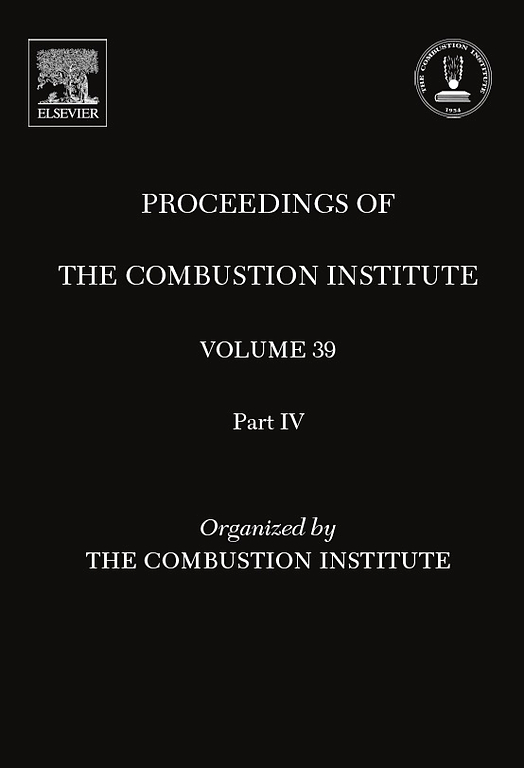高压下[式省略]和[式省略]混合物的瑞利-布里渊散射
IF 5.3
2区 工程技术
Q2 ENERGY & FUELS
引用次数: 0
摘要
本文介绍了在 300 K 和 4 至 60 atm 的压力下,以多种混合物比率测量的和 的二元混合物的瑞利-布里渊散射(RBS)光谱。为了确定与添加有关的线形变化趋势,还包括在 300 K 和类似压力下测量的纯和的光谱。这些测量数据是使用基于空气间隔虚拟成像相控阵的定制光谱仪获得的,该光谱仪的分辨能力约为 10。文中介绍了在以前工作基础上对数据处理程序的改进,包括标量包络校正的修订和色散校正的增加。纯净的 RBS 光谱测量结果与 Tenti S6 模拟的 RBS 光谱进行了比较。在 20 atm 以下的压力下观察到了良好的一致性,而在更高压力下的差异可归因于测量和模型中已知的局限性。观察到布里渊峰和中心瑞利峰的衰减和拓宽,以及布里渊双峰的外移。这些趋势与流体介质中热力学波动的耗散作用有关,流体介质与宿主物种的质量差异增强了这种耗散作用。对 20+ atm 时混合物光谱中的光谱能量分布分析表明,随着稀释度的增加,光谱能量从布里渊双线向中心瑞利峰净转移。实验和模拟的瑞利散射光谱以及 I 型滤波器被用来测试在高压下用混合物成分的分离瑞利散射信号的摩尔分数加权和来近似混合物滤波瑞利散射(FRS)信号的有效性。通过测量混合物光谱计算出的 FRS 信号与通过模拟纯气体光谱计算出的近似值进行了比较。结果显示,两者的一致性有限且不一致。在一致性较强的地方,进一步的分析表明,影响 FRS 信号生成的各种因素之间存在着敏感的平衡,而这种平衡对于稳健的 FRS 信号反演并不可靠。这项工作表明,需要改进光谱模型,以支持将 FRS 诊断应用于高压下的流体混合物。本文章由计算机程序翻译,如有差异,请以英文原文为准。
Rayleigh-Brillouin scattering from [formula omitted] and [formula omitted] mixtures at elevated pressures
This paper presents spectral measurements of Rayleigh-Brillouin scattering (RBS) spectra in binary mixtures of and at a number of mixture ratios at 300 K, and pressures ranging from 4 to 60 atm. To identify trends in lineshape changes associated with addition, measured spectra of pure and at 300 K and similar pressures are included. These measurements were acquired with a custom spectrometer based on an air-spaced virtually-imaged phased array whose resolving power was on the order of 10. Improvements upon previous work to the data processing procedure, including revised implementation of the scalar envelope correction, and the addition of a dispersion correction, are described. Measurements of RBS spectra in pure and are compared to their counterparts modelled by Tenti S6. Good agreement is observed in pressures up to 20 atm, and discrepancies at higher pressure are attributable to known limitations in the measurements and model. Attenuation and broadening of the Brillouin and central Rayleigh peaks, as well as an outward shift of the Brillouin doublet, are observed with addition. These trends are related to the dissipative role of on thermodynamic fluctuations in the fluid medium, enhanced by its mass disparity with the host species. Analysis of spectral energy distribution in mixture spectra at 20+ atm reveals a net transfer of spectral energy from the Brillouin doublet towards the central Rayleigh peak with increasing dilution. Experimental and modelled RBS spectra, and a model I filter, are used to test the validity, at elevated pressure, of approximating a mixture filtered Rayleigh scattering (FRS) signal by a mole fraction-weighted sum of isolated FRS signals from mixture constituents. FRS signals calculated from measured mixture spectra are compared to their approximations calculated from modelled pure gas spectra. Results show limited and inconsistent agreement. Where agreement is strong, further analysis reveals a sensitive counterbalance of factors affecting FRS signal generation that is not reliable for robust FRS signal inversion. The work demonstrates the need for improved spectral models to support the application of FRS diagnostics to fluid mixtures at elevated pressure.
求助全文
通过发布文献求助,成功后即可免费获取论文全文。
去求助
来源期刊

Proceedings of the Combustion Institute
工程技术-工程:化工
CiteScore
7.00
自引率
0.00%
发文量
420
审稿时长
3.0 months
期刊介绍:
The Proceedings of the Combustion Institute contains forefront contributions in fundamentals and applications of combustion science. For more than 50 years, the Combustion Institute has served as the peak international society for dissemination of scientific and technical research in the combustion field. In addition to author submissions, the Proceedings of the Combustion Institute includes the Institute''s prestigious invited strategic and topical reviews that represent indispensable resources for emergent research in the field. All papers are subjected to rigorous peer review.
Research papers and invited topical reviews; Reaction Kinetics; Soot, PAH, and other large molecules; Diagnostics; Laminar Flames; Turbulent Flames; Heterogeneous Combustion; Spray and Droplet Combustion; Detonations, Explosions & Supersonic Combustion; Fire Research; Stationary Combustion Systems; IC Engine and Gas Turbine Combustion; New Technology Concepts
The electronic version of Proceedings of the Combustion Institute contains supplemental material such as reaction mechanisms, illustrating movies, and other data.
 求助内容:
求助内容: 应助结果提醒方式:
应助结果提醒方式:


